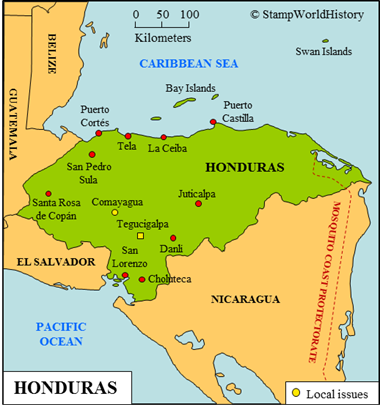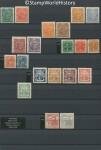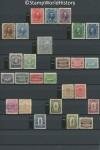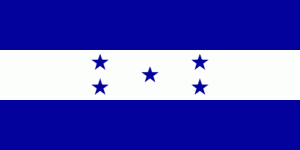
Honduras
Quick reference
General issues: Republic 1866-1896, State of the Greater Republic of Central America 1896-1898, Republic 1898-Present
Country name on general issues: Honduras
Special issues: Local issues Comayagua 1877, Tegucigalpa 1877
Currency: 1 Peso = 8 Reales = 100 Centavos 1866-1933, 1 Lempira = 100 Centavos 1933-Present
Population: 543 000 in 1901, 8 098 000 in 2013
Political history Honduras
Colonization
Honduras is located in Central America. In the first millennium, Honduras was populated by Maya peoples. After the Mayans left, Honduras came to be populated by a range of different peoples – some from Mayan descent, some having moved in from the south. The first European to explore Honduras was Columbus in 1502. Colonization started in 1524 with the first Spanish settlement. In 1552, Honduras was made a province of the Captaincy General of Guatemala – legally part of the Viceroyalty of New Spain but in practice self governing. Honduras was of importance to the Spanish because of its rich silver mines. In the 17th century, the Spanish were confronted by incursions from the British. In 1740, the British established the Mosquito Coast protectorate, part of which extends into Honduras. Furthermore the British settled on the Bay Islands, off the coast of Honduras. In the late 18th century the sovereignty over these territories was returned to the Spanish.
The road to independence
After Napoleon had conquered Spain, a wave of independence movements swept across the Spanish possessions in the Americas. The war of independence in Central America was fought from 1810 in the Viceroyalty of New Spain, that gained independence as the Empire of Mexico in 1821. The provinces of the Captaincy General of Guatemala proclaimed independence from Spain the same year – without a shot being fired. In 1822, the provinces joined the empire of Mexico. The empire, however, was short lived and, as the empire was dissolved in 1823, the provinces of the former Captaincy General proclaimed independence from Mexico as the United Provinces of Central America. By the constitution of 1824, the provinces would form the federal republic of Central America. The province of Honduras was proclaimed the state of Honduras in the same year. The federal fepublic of Central America would suffer from conflicts between the member states and that would soon lead to its dissolution. Honduras withdrew from the Federation in 1838 to become the fully independent state of Honduras.
Border issues
Claims by foreign powers have led to territorial disputes. The British reasserted their claims to the Bay Islands and the Mosquito Coast in the early 19th century – settling on the Bay Islands and reviving the protectorate over the Mosquito Coast. The conflict that ensued was settled in 1860 when the British reneged their claims. The Swan Islands were annexed by the United States in 1863. The islands were returned to Honduras in 1971.
With the neighboring countries de facto borders were established in the 1820’s. De jure the borders would be disputed until well into the 20th century. The border with Guatemala was settled in 1933, the border with Nicaragua in 1960 and finally the border with El Salvador in 1992.
Independent Honduras

Modern day Honduras has a high crime rate. The government deploys the army to fight crime.
Honduras was proclaimed a republic in 1865. From 1896 until 1898, Honduras was part of the short lived Greater Republic of Central America, a federation with El Salvador and Nicaragua.
Two elements would seem to be characteristic of political developments in Honduras: continuous turmoil and a large United States influence.
Legally Honduras is a constitutional, representative democracy. Reality proves to be different. Governments in Honduras have – from independence until the present day – often gained and lost power through other than democratic means and have often been short lived. The military has had a large influence on politics – resulting in many military coups and periods of military rule. Although in the second part of the 20th century attempts have been made to curb the influence of the military, it is, until the present day, a factor to be reckoned with. The last military coup dates from 2009. Currently a democratically elected president is in power.
The United States has had – from the late 19th century – a large influence in Honduras. In the late 19th and early 20th centuries United States companies established large banana plantations in Honduras. To protect United States interests, the United States intervened in Honduras by military force no less than seven times between 1903 and 1925. The United States influence has lasted throughout the 20th century. Currently the United States are by far the most important trade partner of Honduras.
Economics and demography
Economically, Honduras is a developing country. Traditionally, agriculture – bananas and coffee – was the backbone of the economy. Nowadays the economy has diversified with developing sectors in industry and services. Many Hondurans live abroad – remittances from abroad account for 20% of the GDP. On the United Nations Human Development Index Honduras is qualified as a middle high development country, the least developed country in Central America. Honduras has a high crime rate; the homicide rate is the highest in the world by far. The population consists of 90% mestizos – people of mixed white and Amerindian origin. The indigenous Amerindian people account for 7% of the population.
Postal history Honduras
The first stamps were issued in Honduras in 1866 with a design showing the seal of Honduras. Used, these stamps are extremely rare. Unused, they are readily available and have a low catalog value. The reason is that – although a decree had ordered the use of stamps – the use of stamps was all but common place. Most letters continued to be marked with hand stamps indicating whether postage fees had been paid by the sender or were to be paid by the addressee. Thus, used items are rare. As the stamps were demonetized in 1878, large numbers of remainders were sold to the collectors market and, therefore, unused items have a low catalog value. The 1866 stamps were reissued in 1877 by the cities of Comayagua and Tegucigalpa, overprinted with new face values. Again, used items are rare. Unused items of these issues, however, are much less common and range in the middle to high catalog values.
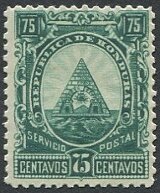
1890 – The first Seebeck issue, showing the seal of Honduras. The Seebeck issues are often frowned upon because of their commercial nature, but the stamps as such are quite attractive.
In 1878, a subsequent set of definitives was issued, printed by the National Bank Note Company in New York. From 1890 to 1895, the stamps of Honduras were printed by the Hamilton Bank Note Company, also in New York, under the Nicholas Seebeck contracts. Seebeck – a director of Hamilton Co – signed a contract with Honduras – as with Ecuador, El Salvador and Nicaragua – that implied he would print stamps free of charge, valid for only one year. Any unsold stamps were to be returned to Seebeck for sale to collectors. Seebeck also had the right to reprint stamps. The Seebeck issues are most often found mint or cancelled to order. Part of the contract with Seebeck was a provision that Seebeck had the right to sell the remainder of the 1878 issues. As not enough were available, reprints were produced by the successor of National Bank Note Company – the American Bank Note Company – and handed to Seebeck to sell to collectors. None of these reprints have been sold officially for postal use. Covers with used items do exist, but these were sent by agents of Seebeck to pass in the mail stream as 1878 issues.
Honduras has, from its first issues until today, issued stamps with mainly themes of national interest.
Album pages
← Previous page: HawaiiNext page: Inini →

